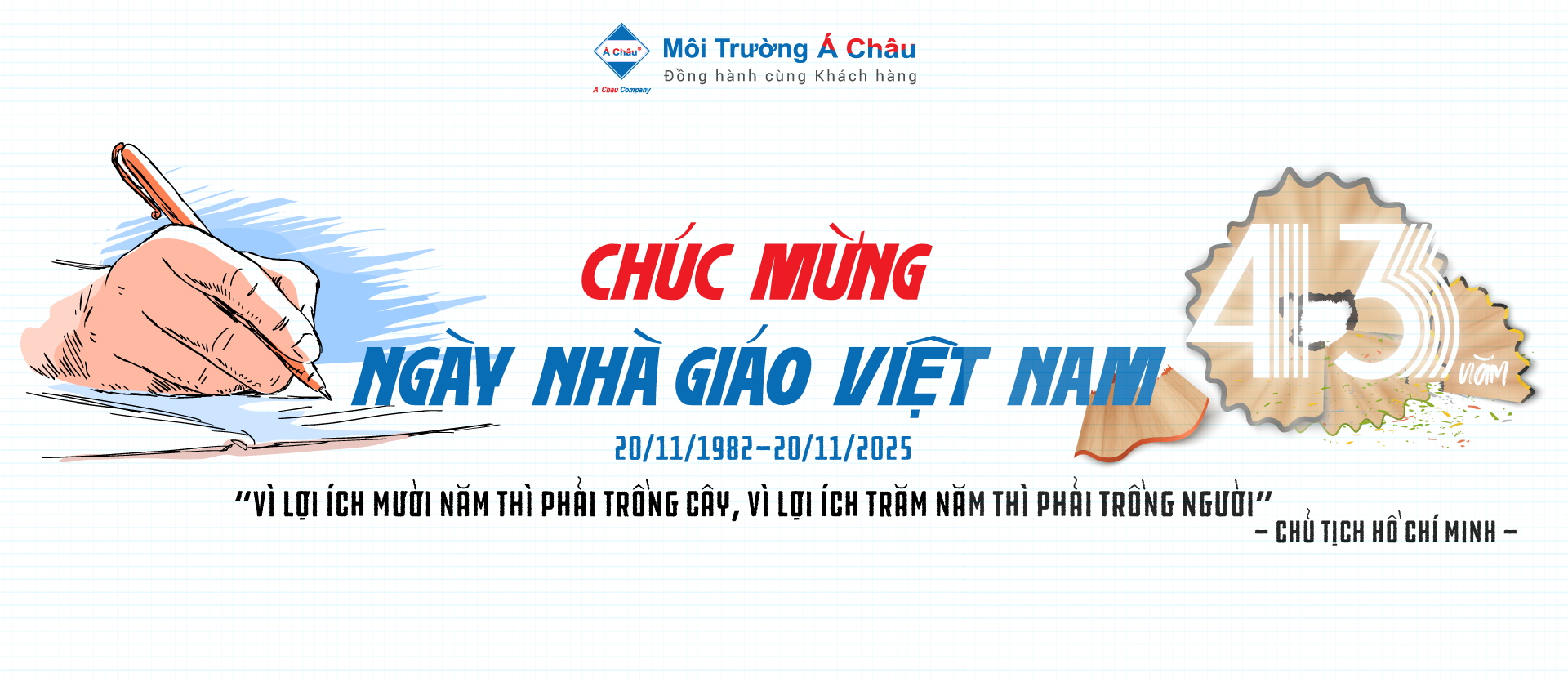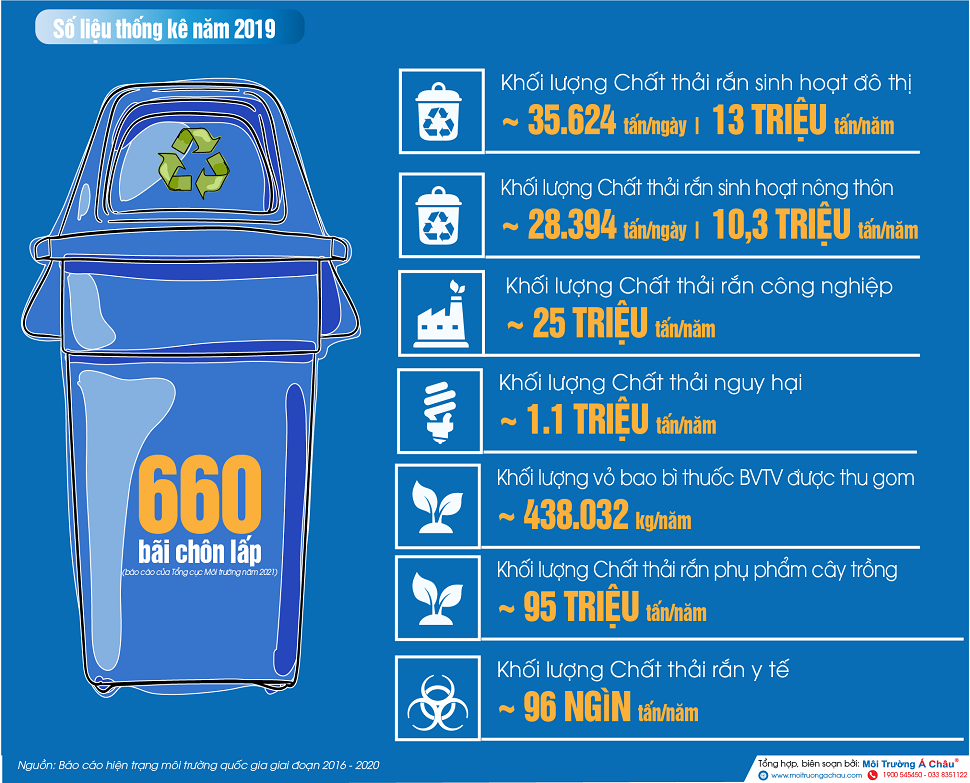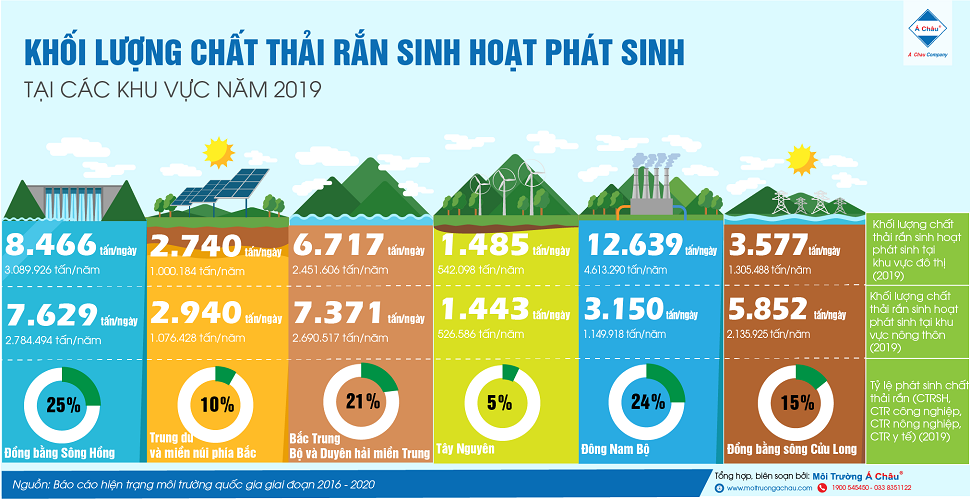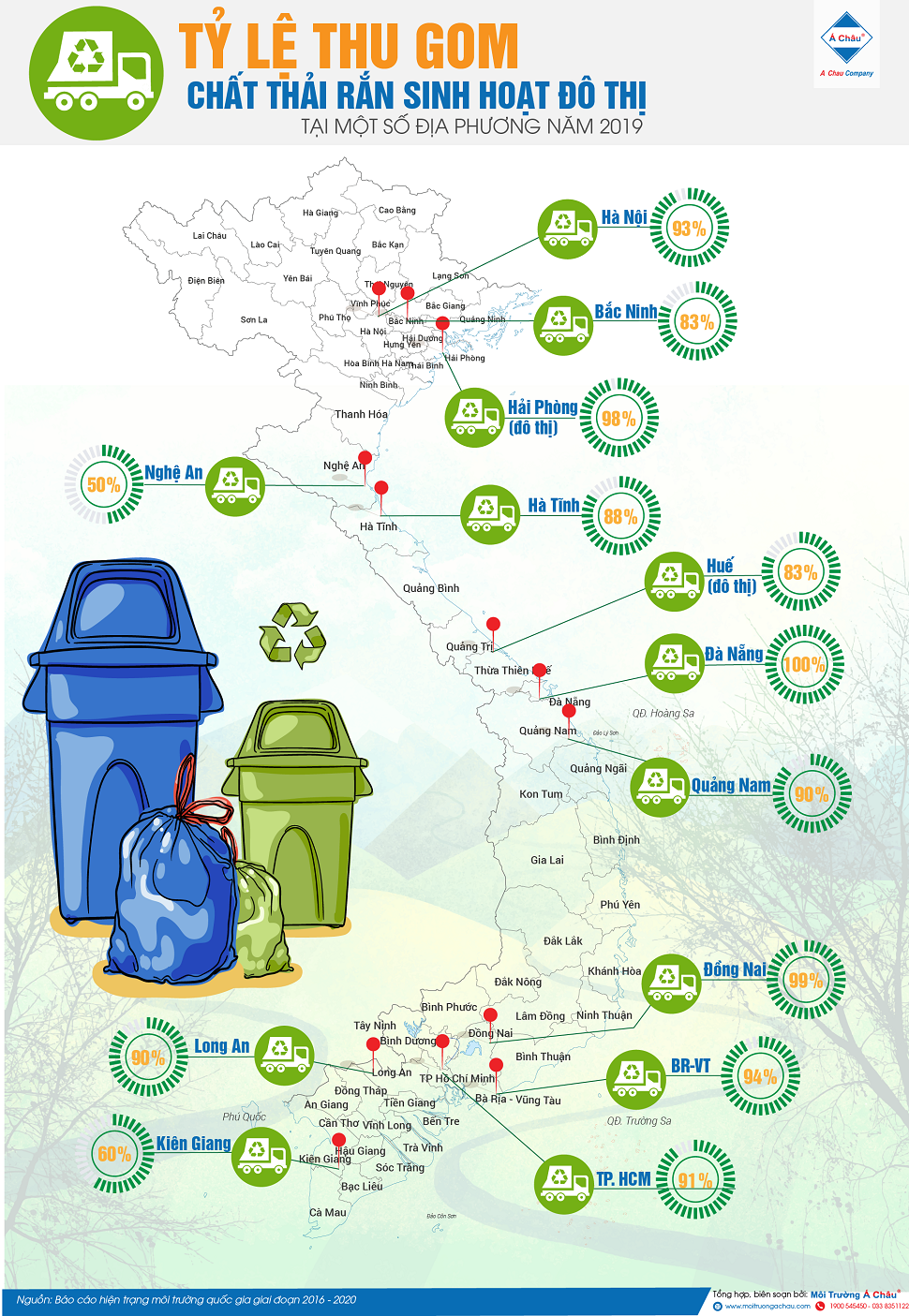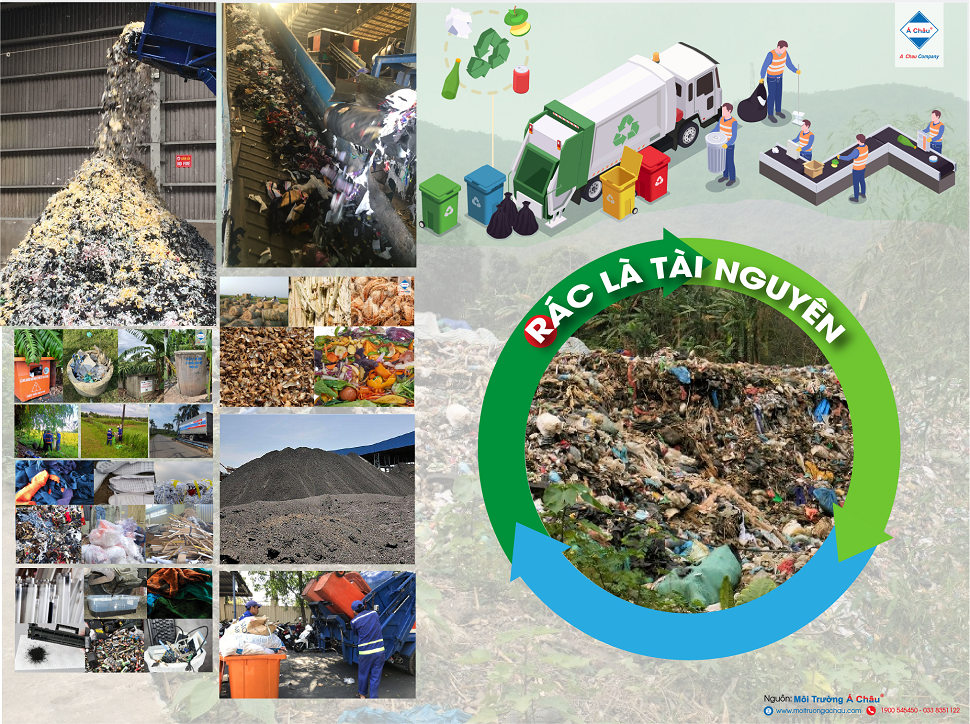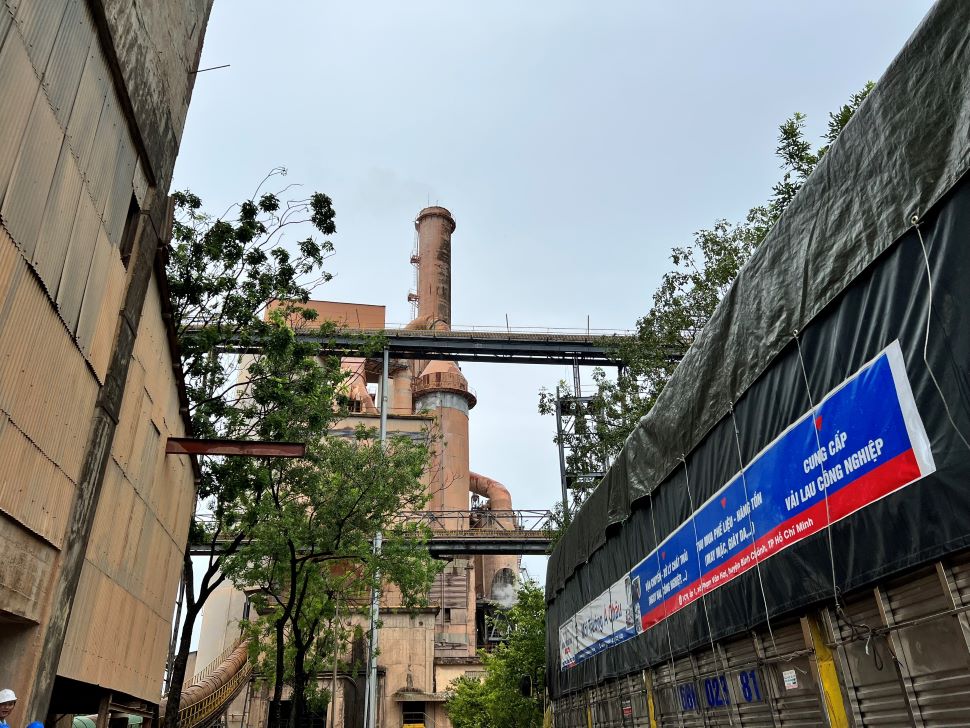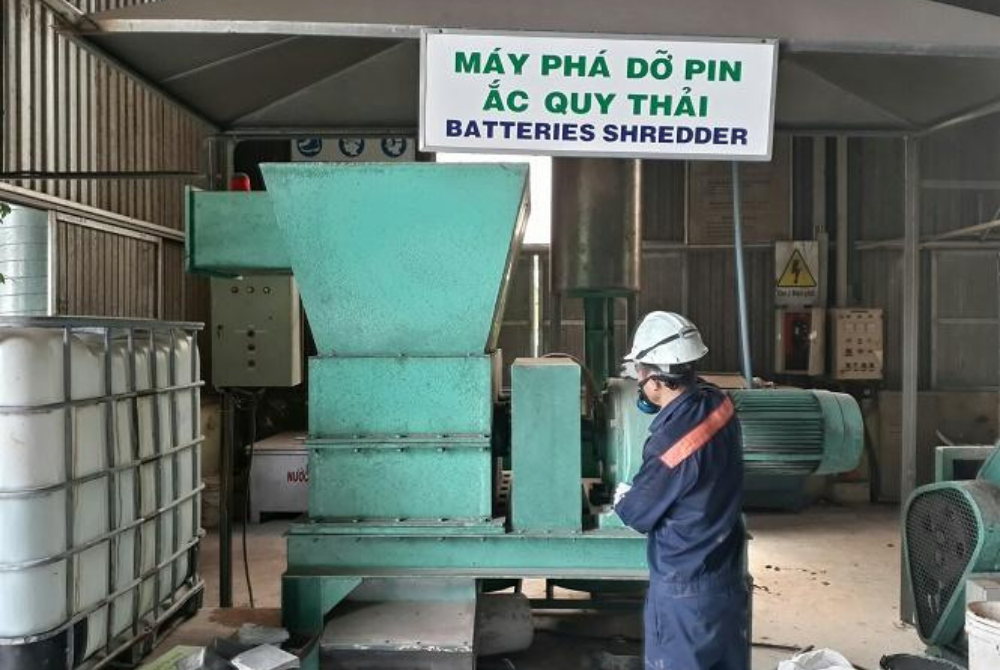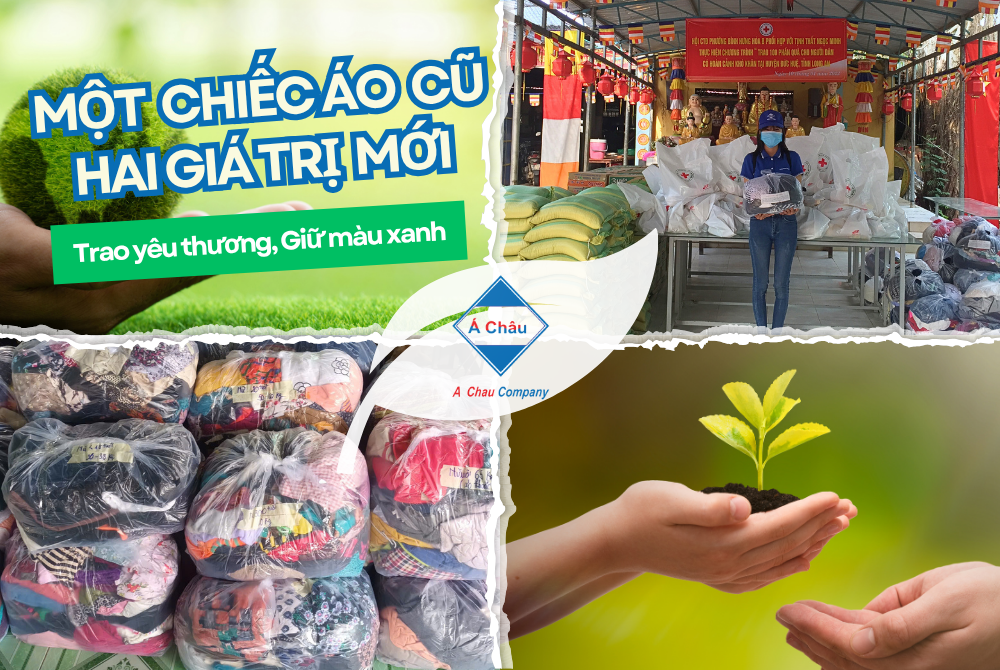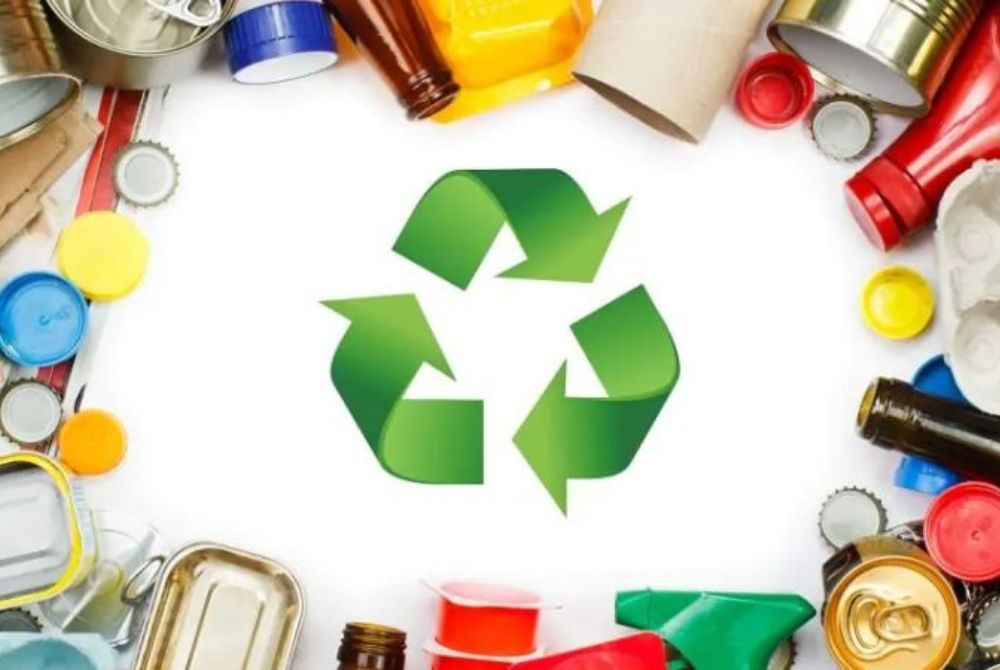Status quo of domestic waste segregation at Source and recycling in Vietnam
As per the figure, the country generates more than 60,000 tons of waste every day. However, only about 15% of collected waste is recycled or reused. The remainder is buried in landfills, discharged into water sources or burned for typical destruction. Recently, there have been a number of Waste Power Plants, but compared to the volume of waste generated, it could be more significant.
Overview of domestic solid waste management in Vietnam
As stated in "National Environmental Status Report 2016-2020," published by the Ministry of Natural Resources and Environment (MONRE) at the end of 2021, the amount of domestic solid waste (MSW) continues to increase nationwide, reaching an average of 64,658 million tons/day.
The estimated amount of MSW in urban areas increases by an average of 10-16%/year (with a total volume of 35,624 tons/day, more than 13 million tons/year, accounting for 55% of the total volume of MSW generated in the country).
Also, according to statistical results for the period 2016-2019, the speed of urban MSW collection and treatment increased by an average of 2%/year, most of which was only treated by rudimentary landfilling.
Economic growth partly changes society's consumption patterns, which in turn leads to changes in the volume and composition of domestic solid waste generated. Managers have recognised the presence of many toxic and difficult-to-decompose solid waste components in Vietnam's urban domestic solid waste.
Urban solid waste collection rate of some Vietnamese cities.
Source: National Environmental Status Report 2019, Topic: Solid Waste - MONRE2019
Status Quo of waste segregation at source in Vietnamese provinces and cities
Along with strong economic development and the impact of urbanisation, the amount of solid waste generated in Vietnam is increasing at a rate of about 10% each year. According to estimates, the country generates more than 60,000 tons of waste every day. However, only about 15% of collected waste is recycled or reused.
The remainder is buried in landfills, discharged into water sources or burned for regular destruction (without energy recovery). Recently, there have been a number of waste incineration plants to recover energy, also known as waste power plants, such as in Hanoi, Ho Chi Minh City, Can Tho...
However, compared to the volume of waste generated nationwide, this figure could be more significant.
Waste segregation at source contributes to creating a source of raw materials for recycling activities and reducing the volume of landfilled domestic solid waste. However, currently, Waste Segregation Programs in localities are mostly only experimental, not synchronised, drastic and formalised.
15 years ago, Hanoi also implemented a waste segregation project at source (3R) sponsored by the Japan International Cooperation Agency (JICA). The four million USD project was piloted in four wards of Hanoi's inner city, including Phan Chu Trinh, Nguyen Du, Thanh Cong and Lang Ha.
From 2006 to the end of 2009, 18,000 families were trained on how to classify waste at source. However, after the project ended, the segregation of MSW in Hanoi still needed to be maintained. The reason is that we need to be adequately prepared; Waste treatment processes and technologies need to be more appropriate and consistent.
Waste is segregated into recyclable, inorganic, and organic waste, of which a part is processed and produced into microbial fertiliser. Still, the output for this type of fertiliser could be more stable and more accessible to digest. Consumed in the market, and there is no unit to purchase the product...
Ho Chi Minh City has implemented pilot source segregation of MSW since 2002 with an excellent roadmap. If in 2017, each district implemented at least one ward/commune/town, in 2018, the number will be expanded from 3-5 and throughout the city by 2020. However, the results obtained are very modest.
Some other provinces and cities also have similar projects, such as Hung Yen (2012- 2014), Bac Ninh (2014), Lao Cai (2016), Binh Duong (2017-2018), Dong Nai (2016- 2018 ), Da Nang (2017), Ha Tinh (2019)... However, the results obtained are modest.
The reason is that the collection and transportation equipment and vehicles are not suitable for the classified MSW; Many places apply one treatment method to all collected MSW; Implementation costs for typing MSW at source are high; lack of a comprehensive communication program on MSW sort at source.
Assessing the current situation of MSW management in Vietnam, especially waste segregation at source, processing and recycling technology, and MSW fee collection, is essential in the spirit of the Law on Environmental Protection 2020.
Waste Segregation at source is an expression of the Circular Economy that will move towards "No Waste". We can process and recycle all types of waste. But to do that, we must have technology and waste segregation at source. If we sort waste well, it will limit landfilling. , burning trash causes many environmental consequences.
Some experiences in segregation of domestic solid waste at source
By the experience of Japanese experts: First of all, technically, the segregation of domestic solid waste at source requires:
- Distribution by territory: urban, coastal, and rural: Distribution by territory to match the composition and nature of the waste to choose the method of classification, according to population density with the amount of waste generated to the arrangement of collection, transportation, and treatment technology.
- Determine the collection method.
- Responsibilities of authorities at all levels for each type of solid waste.
About collection methods for each type of waste
+ Food waste: Organize separate collection locations (in groups of restaurants and households).
+ Recyclable waste: Organize combined collection locations.
+ Bulky waste: Organize collection as required (waste source owner must notify the collection unit about waste type and size).
+ Hazardous waste (contained in domestic solid waste): Organize collection at separate or combined collection locations.
+ Remaining waste: Collected directly.
About the responsibilities of authorities
+ Make a plan to segregate waste at the source with the application of service fees based on waste volume. Arrange combined collection points in the area.
+ Develop a registration/monitoring system for community groups/business establishments (process and content of registration, monitoring activities including information such as reduced waste volume). , forms of support, encouragement of groups, registration deadline).
+ Train core staff to direct implementation of identified community groups/business establishments.
+ Guide and monitor the implementation of large waste owners (Monitor waste reduction plans of large waste owners and develop solid waste management records, check implementation at business establishments).
+ Build a bulky waste collection system in the area (Collection and repair of furniture, etc.).
+ Build a system to collect the remaining waste that needs to be treated.
+ Adjust contract content for waste collection and transportation contractors in the area.
+ Arrange budget sources for activities.
Current status of urban waste recycling
According to a summary of MONRE, MSW recycling activities are still small and spontaneous, mainly carried out by the informal sector in craft villages, causing environmental pollution. Most recycling facilities are small-scale, the level of technology investment is low, and most of the technology needs to be updated. Old machinery and equipment cause secondary environmental pollution.
The primary method of treating MSW is still landfilling. Landfills have mainly existed for a long time, consuming land funds. The rate of waste recycled, processed and combined with energy recovery is still low. Many MSW treatment facilities that recycle organic components into biofertilisers (composting) have been built and operated but still need to meet environmental protection requirements.
According to Decree 08/2022/ND-CP dated January 10, 2022, of the Government, Waste recycling is the process of using technological and technical solutions to recover valuable components from waste.
Most components in domestic solid waste can be recycled. Only a tiny percentage of waste remains that must be landfilled. This will save a lot on disposal costs compared to burying it or burning it completely.
Recycling waste is not only environmentally significant but also brings economic benefits. They reduce human dependence on the exploitation and use of gradually depleting natural resources.
Recycling waste is one of the ways to help limit the exploitation of natural resources. Specifically, 135 tons of recycled waste can save 3.5 million litres of water, 1.9 million trees, and 500,000 KW/h, and reduce 3 tons of air pollutants and 1,300 m3 of landfill land.
Plastic waste recycling: Report "Market Research for Vietnam - Opportunities and barriers for plastic recycling" recently published by IFC; each year, about 3.9 million tons of PET, LDPE, HDPE plastic and PP are consumed in Vietnam. Of this, only 1.28 million tons (33%) are collected for recycling (CFR).
Therefore, up to 2.62 million tons of plastic are discarded, leading to a loss of 75% of the material value of plastic, equivalent to 2.2 - 2.9 billion USD per year. If it were all collected and recycled into valuable products, the total value of materials liberated through recycling would be equivalent to $3.4 billion per year.
"Waste is a resource" - Some reuse and recycling solutions of A Chau Environment.
- A Chau Environment is proud to be the unit that directly reuses rags into industrial cleaning cloth. More than 5,000 tons of garments from reused rags are supplied to the market per year.
- From 2020, each month, more than 10,000 tons of garment waste will be managed with "no landfill" solutions.
- For industrial wastes that no longer have recycling value or have low recycling potential, A Chau Environment is pre-processing (cuts, grinds). It is suitable to become an input source of fuel to replace fossil fuels. Traditional (coal, oil) supplied directly to cement factories.
Photo: Activities of supplying raw materials and alternative fuels for cement production in A Chau Environment
Accompanying sustainable waste management solutions
Source: Prof. Dr. Nguyen Huu Dung, Vietnam Institute of Urban Environment and Industry
